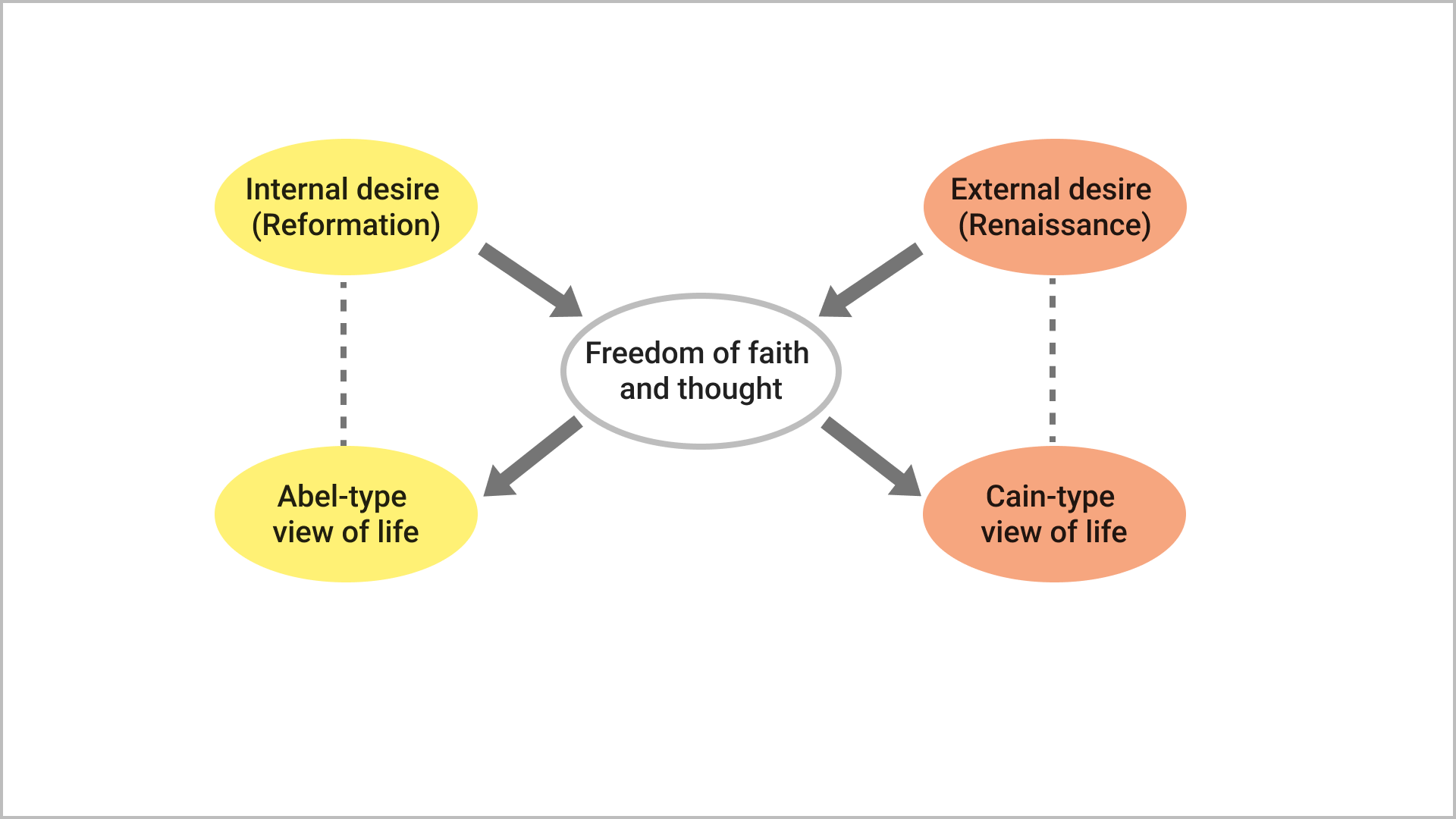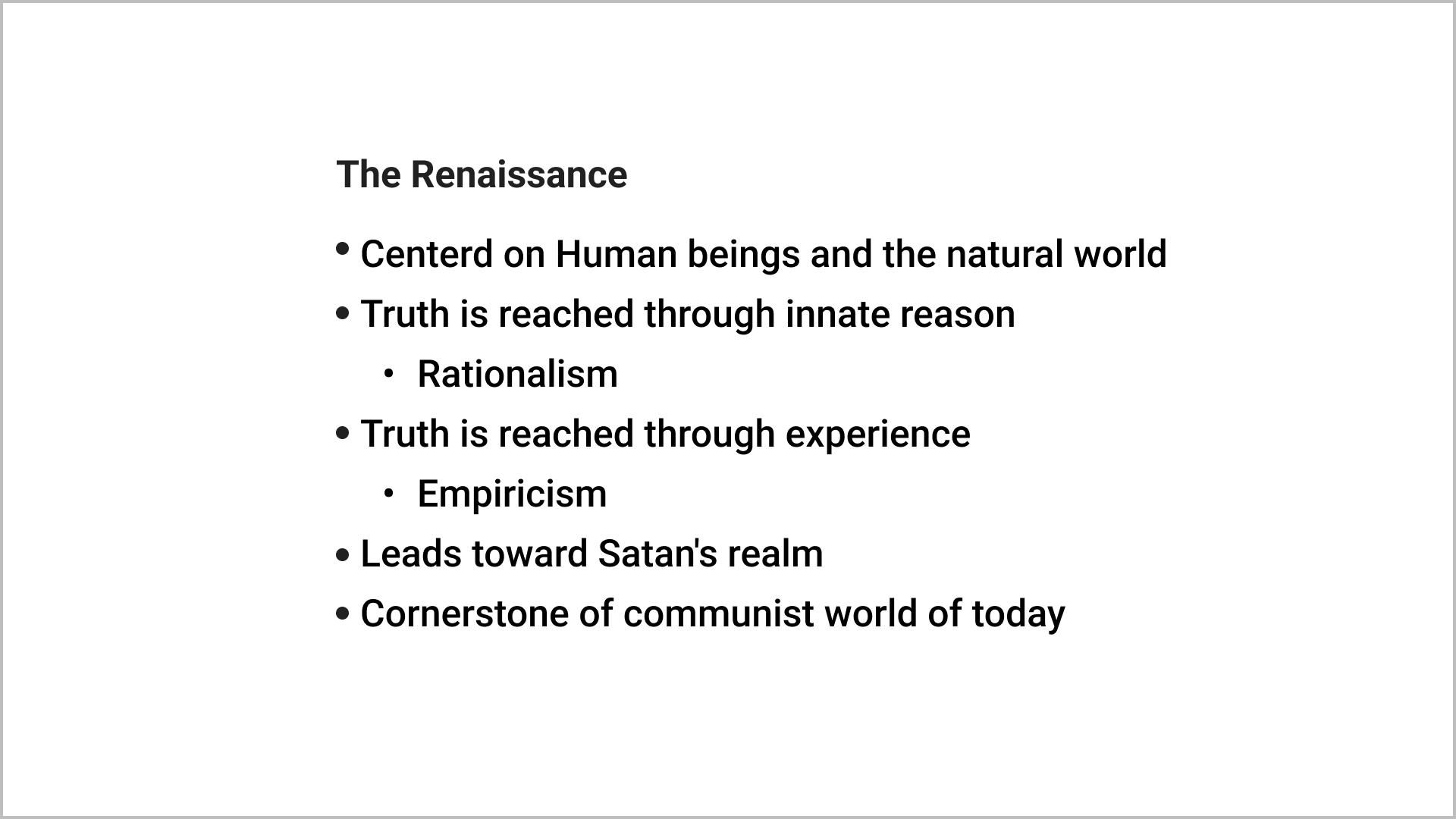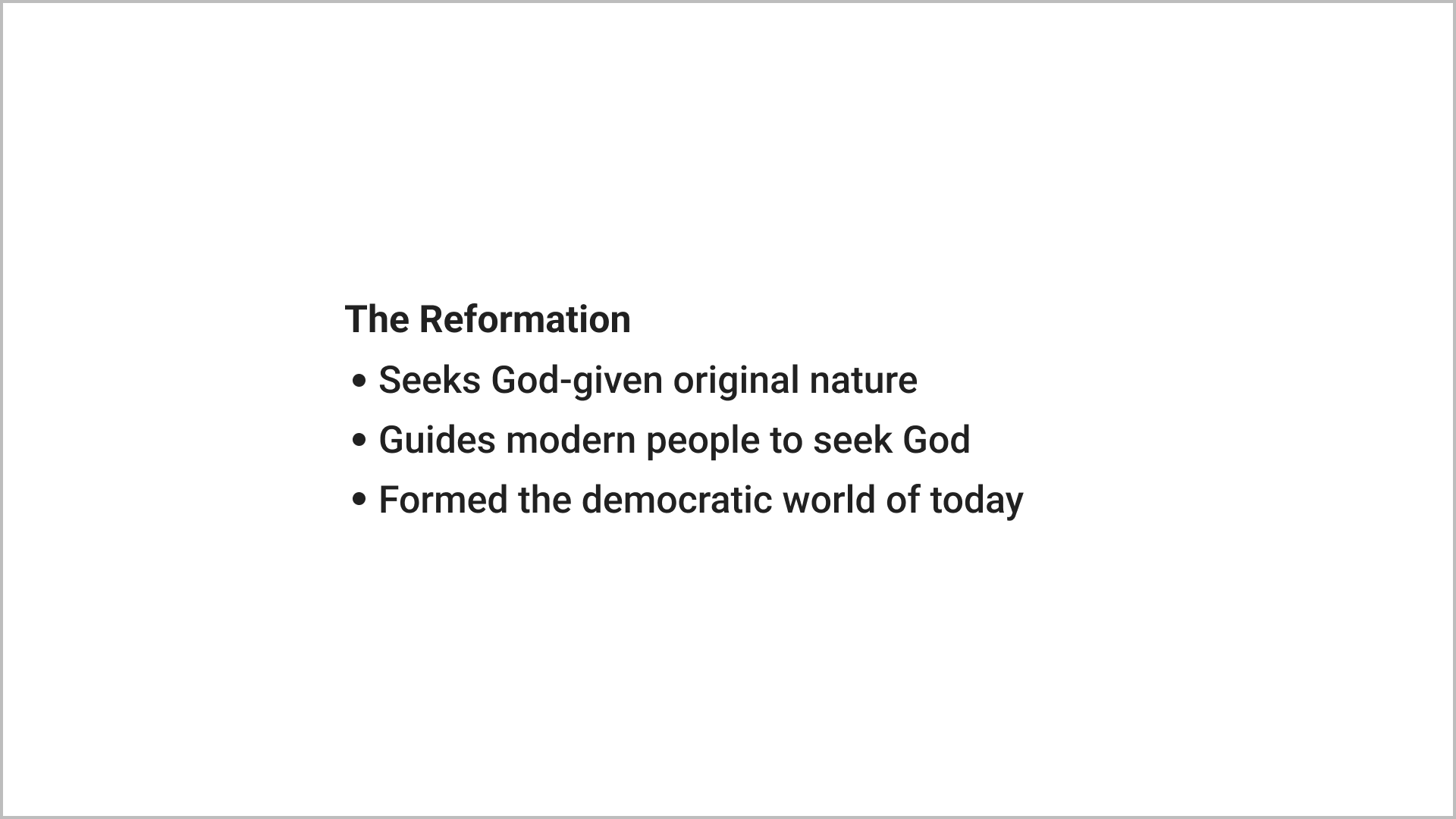이 기간은 서기 1648년 베스트팔렌조약으로 신교운동이 성공한 이후 1789년 불란서혁명(佛蘭西革命)이 일어날 때까지의 140년 기간을 말한다. 문예부흥(文藝復興)과 종교개혁(宗敎改革)에 의하여 인간 본성의 내외 양면의 욕망을 추구하는 길을 개척하게 된 근세인(近世人)들은, 신교(信敎)와 사상의 자유로부터 일어나는 신학 및 교리의 분열과 철학의 싸움을 면할 수 없게 되었었다.
The period of religious and ideological conflicts refers to the 140 years beginning with the secure establishment of Protestantism at the Treaty of Westphalia in 1648 and ending with the French Revolution in 1789. As modern people continued to pursue the internal and external desires flowing from their original nature, they could not avoid divisions in theology and disputes among philosophies which arose as they exercised freedom of faith and thought.
그런데 지금까지 후편에서 논해 온 바와 같이, 복귀섭리(復歸攝理)는 오랜 역사의 기간을 두고 개인에서 세계에 이르기까지 가인 아벨 두 형의 분립역사(分立役事)에 의하여 이루어져 나오고 있다. 따라서 역사의 종말에 있어서도 이 타락세계(墮落世界)는 가인형의 공산세계(共産世界)와 아벨형의 민주세계(民主世界)로 분립되는 것이다. 그리하여 마치 가인이 아벨에게 순종굴복함으로써만 ‘실체기대(實體基臺)’가 이루어질 수 있었던 것과 같이, 이때에도 가인형의 세계가 아벨형의 세계에 굴복함으로써만 재림주님을 맞기 위한 세계적인 ‘실체기대’가 이루어져서 하나의 세계를 복귀하게 된다. 이와 같이 가인 아벨 두 형의 세계가 이루어지려면 그를 위한 두 형의 인생관(人生觀)이 확립되어야 하는데, 기실 이 두 형의 인생관은 이 기간에 확립되었던 것이다.
As previously discussed, God has worked His providence of restoration throughout the course of history by repeatedly separating those representing Abel from those representing Cain, from the individual level to the world level. In the Last Days, this fallen world is divided into the Cain-type communist world and the Abel-type democratic world. Just as the foundation of substance could have been laid in Adam’s family had Cain submitted to Abel and obeyed him, in the Last Days the Cain-type world is to submit to the Abel-type world to establish the worldwide foundation of substance. This is necessary before we can receive Christ at the Second Advent and realize the unified world. For this to happen, the two views of life which would later mature into these two worlds had to be developed in this period.

2.1 The Cain-Type View of Life
인간 본성의 외적인 추구는 헬라사상의 복고운동을 일으키어 인본주의(人本主義)를 낳았고, 인본주의를 뒷받침으로 하여 일어난 반중세적(反中世的)인 문예부흥운동(文藝復興運動)은 신에의 귀의와 종교적인 헌신을 가벼이 하고 모든 것을 자연과 인간 본위로 대치시켰다. 즉 신에 복종한 나머지 자연이나 인간의 육신을 천시하여 죄악시하는 데까지 이르렀던 중세적인 인생관에서, 이성(理性)과 경험(經驗)에 의한 합리적인 비판과 실증적인 분석을 통하여 인간과 자연을 인식함으로써 그들의 가치를 높이는 인생관을 확립하였던 것이다. 이러한 인생관은 자연과학의 발달로부터 오는 자극으로 인하여 인생에 대한 인식(認識) 사유(思惟)의 방법론에 두 가지 형식을 밟게 되었다. 그리하여 이것들이 근세철학(近世哲學)의 2대 조류를 이루게 되었으니 하나는 연역법(演繹法)에 의한 이성론(理性論)이요, 또 하나는 귀납법(歸納法)에 의한 경험론(經驗論)이다.
The pursuit of the external aspects of the original nature first aroused a movement to revive the ancient heritage of Hellenism and gave birth to the humanism of the Renaissance. Renaissance humanism opposed medieval culture by elevating the dignity of human beings and the value of the natural world over devotion to God and religious dedication. The medieval mind had prized obedience to God while belittling the natural world and regarding the human body as base and even sinful. The Renaissance established a new perspective on life, one which exalted the value of human beings and nature and sought to understand them through reason and experience, logic and experiment. Spurred by the progress of natural science, this view of life gave rise to two major schools of modern philosophy: rationalism, based on the deductive method and empiricism, based on the inductive method.
불란서(佛蘭西)의 데까르뜨(Descartes 1596∼1650)를 비조(鼻祖)로 하는 이성론은, 모든 진리는 인간이 나면서부터 가지고 있는 이성에 의하여서만 탐구된다고 주장하였다. 그들은 역사성이나 전통을 타파하고 연역법을 근거로 하여 ‘나는 생각한다. 그러므로 나는 있다’는 명제를 세우고 이로부터 연역함으로써 비로소 외계(外界)를 긍정하려는 것이다. 따라서 그들은 신(神)이나 세계나 자기까지도 부정하는 입장에 서려 했던 것이다.
Rationalism, founded by the French philosopher Rene Descartes (1596-1650), maintained that the investigation of truth can be founded only on man’s innate reason. After doubting every truth received from history and tradition, Descartes was left with only his reason, as expressed in the proposition, “I think; therefore, I am.” From this first principle, he used the deductive method to affirm knowledge about the external world. Although Descartes accepted and even tried to prove the existence of God based on reason, later rationalists ended up doubting or even denying God’s existence.
이에 대하여 영국의 베이컨(Bacon 1561∼1626)을 비조로 하는 경험론은 모든 진리는 경험에 의하여서만 탐구된다고 주장하였다. 인간의 마음은 마치 백지와 같아서 새로운 진리를 체득하려면 모든 선입관을 버리고 실험과 관찰에 의하여 인식해야 된다고 하였다. 이와 같이 신을 떠나서 이성(理性)을 존중시하는 합리주의사상(合理主義思想)과 경험에 토대를 둔 인간 중심의 현실주의사상(現實主義思想)은 한가지로, 신비와 공상을 배격하고 인간생활을 합리화하며 현실화하여 자연과 인간을 신으로부터 분리하였던 것이다.
The English philosopher Francis Bacon (1561-1626) founded empiricism, which held that truth can be investigated only through one’s experience. This school asserted that the human mind is like a blank sheet of paper (tabula rasa). It held that to attain new knowledge, one must erase all prejudices and try to comprehend the truth through experience and observation of the external world. Rationalism, which valued human reason while turning away from God, and empiricism, which prized human experience and experimental science, both did away with mysticism and superstition. Whether by using reason or empirical observation to guide human life, they both tended to divorce human beings and the natural world from God.
이와 같이 문예부흥(文藝復興)은 인문주의(人文主義)로부터 흘러온 두 사조(思潮)를 타고, 인간이 그의 내적인 성향을 따라 하나님 앞으로 돌아가고자 하는 길을 막고 외적인 성향만을 따라서 사탄편으로 돌아가는 길을 열어 주는 인생관을 낳게 되었으니, 이것이 바로 가인형의 인생관이었다. 이 가인형의 인생관은 18세기에 이르러서는 역사와 전통을 타파하고, 인생의 모든 것을 이성적 또는 현실적으로만 판단하며, 불합리한 것이나 비현실적인 것을 철저히 배격하여 신을 부정하고 합리적인 현실에만 치중하게 되었던 것이니, 이것이 바로 계몽사상(啓蒙思想)이었다. 이와 같이 경험론과 이성론(理性論)을 주류로 하여 피어 오른 계몽사상은 불란서혁명(佛蘭西革命)의 원동력이 되었다.
The Renaissance launched these two currents of thought, which were rooted in humanism. Instead of facilitating the internal inclination to seek God, it gave birth to a view of life which encouraged people to follow only external pursuits. This blocked their path to God and led them toward Satan’s realm. For this reason, it is called the Cain-type view of life. By the turn of the eighteenth century, the Cain-type view of life had broken down the verities enshrined by history and tradition. All matters in human life came to be judged by reason or empirical observation. Anything deemed irrational or other-worldly, including belief in the God of the Bible, was thoroughly discredited. People’s energies were narrowly directed toward the practical life. Such was the ideology of the Enlightenment, which developed out of the two trends of empiricism and rationalism. The Enlightenment was the driving force behind the French Revolution.
이러한 가인형의 인생관의 영향을 받아, 영국에서는 허버트(Herbert 1583∼1648)를 시조(始祖)로 하여 초월신교(Deism)가 생겼다. 토마스 아퀴나스 이래 천계(天啓)와 이성(理性)의 조화에 기초를 두고 발전한 신학에 대하여 초월신교(超越神敎)는 단순히 이성을 기초로 한 신학을 세우려 한 것이었다. 그들의 신관(神觀)은 단순히 인간과 우주를 창조하였다는 일의(一意)에만 국한시키려 하고, 인간에게 있어 신의 계시나 기적은 필요 없는 것이라고 주장하였다. 19세기 초엽 독일의 헤겔(Hegel 1770∼1831)은 18세기 이후에 일어난 관념론(觀念論) 철학을 대성하였다. 그러나 이 헤겔철학도 계몽사상을 바탕으로 하고 불란서에서 일어난 무신론(無神論)과 유물론(唯物論)의 영향을 받아 그를 반대하는 헤겔좌파(左派)의 파생을 가져왔다. 그리하여 이들 헤겔좌파는 헤겔의 논리를 뒤집어서 오늘의 공산세계(共産世界)를 이룩한 변증법적 유물론(辨證法的 唯物論)이란 철학을 체계화하였다. 헤겔좌파인 슈트라우스(Strauss 1808∼1874)는 ‘예수전’을 저술하여 성서에 나타난 기적은 후세의 날조라고 부정하였고, 포이에르바하(Feuerbach 1804∼1872)는 그의 ‘기독교의 본질’에서 사회적 또는 경제적 여건이 종교 발생의 원인이 된다고 설명하였으며, 이러한 그들의 학설은 유물론의 뒷받침이 되었다.
Representative of this Cain-type view of life was deism, founded by the English philosopher Edward Herbert (1583-1648). Deism propounded a theology rooted entirely in human reason. Deists rejected the notion that there could be any harmony between revelation and reason, a traditional view held since the time of Thomas Aquinas. They limited God to a Creator who set the universe in motion and left it to run of its own accord according to the laws of nature which He had set up. They denied that people had any need of divine revelation or miracles. In the beginning of the nineteenth century, the German philosopher G.W. F. Hegel (1770-1831) made a comprehensive synthesis of eighteenth-century idealism. However, many of the followers of Hegel were influenced by the atheism and materialism of the French Enlightenment and propounded the school of left-wing Hegelianism, which turned the logic of Hegel’s dialectic on its head. D.F. Strauss (1808-1874), a left-Hegelian, wrote The Life of Jesus, which denied the Bible’s accounts of Jesus’ miracles as fabrications by his credulous followers. Ludwig Feuerbach (1804-1872) argued in The Essence of Christianity that God was nothing other than the projection of people’s inward psychological nature. Their arguments became foundational for modern atheism and materialism.
마르크스(Marx 1818∼1883)와 엥겔스(Engels 1820∼1895)는 슈트라우스나 포이에르바하의 영향을 받았으나, 그보다도 불란서의 사회주의사상(社會主義思想)에서 더 큰 영향을 받아 변증법적 유물론을 제창함으로써, 문예부흥(文藝復興) 이후에 싹트기 시작하여 계몽사조(啓蒙思潮)로 발전해 온 무신론과 유물론을 집대성하는 데 이르렀다. 그 후에 가인형의 인생관은 더욱 성숙하여 오늘날의 공산주의세계(共産主義世界)를 이루게 된 것이다.
Karl Marx (1818-1883) and Friedrich Engels (1820-1895) systematized the logic of the left-wing Hegelians as dialectical materialism. They were influenced by Strauss and Feuerbach and also by French socialism. They combined dialectical materialism with atheism and socialism to create the ideology of communism. In this way, the Cain-type view of life, which budded after the Renaissance and grew through the Enlightenment into atheism and materialism, matured into the godless ideology of Marxism, which became the cornerstone of the communist world of today.

2.2 The Abel-Type View of Life
우리는 중세사회(中世社會)로부터 근대사회(近代社會)에로의 역사의 흐름을 신이나 종교로부터 인간을 분리 혹은 독립시키는 과정으로만 보기 쉽다. 이것은 어디까지나 중세 사회인의 본성의 외적인 추구에 의하여 일어났던 가인형의 인생관에 입각해서만 보았기 때문에 그러하다. 그러나 중세인들의 본성적인 추구는 이러한 외적인 것에만 멎어졌던 것이 아니라, 한편으로는 보다 더욱 내적인 것을 추구하는 데 이르렀던 것이다. 그리하여 그들의 본성의 내적인 추구가 히브리사상의 복고운동(復古運動)을 일으킴으로써 종교개혁운동(宗敎改革運動)이 일어났고, 이 운동으로 말미암아 철학과 종교는 창조본성(創造本性)을 지향하는 입체적인 인생관을 수립하게 되었으니, 이것을 우리는 아벨형의 인생관이라고 한다. 따라서 가인형의 인생관은 중세인을 신과 신앙으로부터 분리 혹은 독립시키는 방향으로 이끌어 갔지만, 이 아벨형의 인생관은 그들로 하여금 더욱 고차적으로 신을 지향하여 나아가도록 이끌어 주었던 것이다.
Some people regard the progress of history from the medieval to the modern world as a process which has alienated people from God and religion. This is because they view history according to the Cain-type view of life. The original nature, however, not only pursues external values; it also seeks internal values. As medieval people were prompted by their original nature to pursue internal values, a movement arose to revive Hebraism which bore fruit in the Protestant Reformation. The Reformation spawned philosophies and religious teachings which developed a multi-dimensional view of life seeking to realize the God-given, original nature of human beings. We call this the Abel-type view of life. Even as the Cain-type view of life led away from God and faith, the Abel-type view of life guided modern people to seek God in a deeper and more thoughtful way.
독일의 칸트(Kant 1724∼1804)는 서로 대립하여 나왔던 경험론(經驗論)과 이성론(理性論)을 흡수하여 새로이 비판철학(批判哲學)을 세움으로써, 내외 양면을 추구하는 인간 본성(本性)의 욕망을 철학적으로 분석하여 철학적인 면에서 아벨형의 인생관을 개척하였다. 즉 우리의 다양한 감각은 대상(對象)의 촉발로 인하여 생기는 것이지만, 이것만으로는 인식(認識)의 내용만 주어질 뿐이고 인식 자체는 성립되지 않는다. 그 인식이 성립되기 위하여는 다양한 그 내용(이것은 후천적이며 경험적인 것이다)을 일정한 관계에 의하여 통일하는 형식이 없어서는 아니 된다. 그 형식은 바로 나의 주관(主觀)이다. 그러므로 사유(思惟)하는 능력 즉 나의 오성(悟性)의 자발적인 작용에 의하여, 나의 주관적인 형식(이것은 선천적이며 초경험적이다)을 가지고 대상으로부터 오는 다양한 감각을 통합하고 통일하는 데서 인식이 성립되는 것이라고 하였다. 이와 같이 칸트는 대상으로 인하여 주관을 형성한다는 종래의 모사설(模寫說)을 뒤집어, 주관이 대상을 구성한다는 학설을 세우게 되었다.
The German philosopher Immanuel Kant (1724-1804) analyzed philosophically the internal and external pursuits of the original nature, thus pioneering the Abel-type view of life in the philosophical sphere. In his Critical Philosophy, he assimilated the conflicting theories of empiricism and rationalism. According to Kant, our various sensations occur by contact with external objects. These alone may give us the contents of cognition but cannot actualize the cognition itself. To have full cognition, one must possess certain forms of intuition and thought (which are a priori and transcendental) with which to unify the various contents (which are a posteriori and experiential) through a synthetic judgment. These forms of intuition and thought are the very subjectivity of the self. Therefore, cognition is actualized when the various sensations coming from external objects are integrated and unified with one’s subjective forms by the spontaneous action of thinking and understanding. Thus, Kant overturned empiricism, which held that cognition is determined by external objects, and established a new theory that cognition is governed by the subjective mind.
칸트의 학설을 받아, 그의 제1 후계자인 피히테(Fichte 1762∼1814)를 비롯하여 쉘링(Schelling 1775∼1854), 헤겔(Hegel 1770∼1831)등이 배출되었던 것인데, 특히 헤겔은 그의 변증법(辨證法)으로 철학의 새로운 면을 개척하였다. 그들의 이러한 관념론(觀念論)은 철학적인 면에 있어서의 아벨형의 인생관을 형성하였다.
Kant’s philosophy was succeeded by a number of idealist philosophers: Johann G. Fichte (1762-1814), Friedrich Schelling (1775-1854) and G.W. F. Hegel. Hegel, in particular, pioneered a new philosophy based on the Hegelian dialectic. Their idealism solidified the Abel-type view of life in the field of philosophy.
종교계에 있어서는, 당시의 사조(思潮)인 합리주의(合理主義)의 영향을 받고 있던 종교계의 경향을 반대하고 종교적 정열과 내적 생명을 중요시하여, 교리와 형식보다도 신비적 체험에 치중하는 새로운 운동이 일어나게 되었던 것이다.
In the religious sphere, new movements emerged which opposed the prevailing influence of rationalism in religion and stressed the importance of religious zeal and the inner life. They valued mystical experience over doctrines and rituals.
그 대표적인 예를 들어 보면 첫째, 경건주의(Pietism)로서 이것은 독일의 스페너(Spener 1635∼1705)를 중심하고 일어났던 것인데, 정통적 신앙을 따르려는 보수적인 경향이 강하고 신비적인 체험에 치중하였던 것이다. 이 경건파(敬虔派)의 운동이 영국에 파급되어 영국민(英國民)의 생활 속에 스며 있던 종교심(宗敎心)과 융화하여 웨슬레(Wesley) 형제를 중심한 메소디스트(Methodist)파를 일으키게 되었던 것이다. 그리하여 이 교파는 침체상태에 빠져 있던 당시의 영국 교계에 크게 부흥의 기운을 일으켰었다.
For example, Pietism appeared in Germany under the leadership of Philip Spener (1635-1705). This movement had a strong conservative bent and adhered to the traditional faith while simultaneously emphasizing mystical experience. Pietism spread to England and flourished among the faithful there, giving rise to new church movements including Methodism, founded by the Wesley brothers (John, 1703-1791, and Charles, 1707-1788). Their work brought about a great revival in England, which had been in a state of spiritual stagnation.
또 영국에는 신비주의자 폭스(Fox 1624∼1691)를 비조로 한 퀘이커(Quaker)파가 일어났다. 폭스는 그리스도는 신자의 영혼을 비치는 내적인 빛이라고 주장하면서, 성령(聖靈)을 받아서 그리스도와 신비적으로 연합하여 내적 광명을 체휼하지 않으면 성서의 진의(眞意)를 알 수 없다고 주장하였다. 이 교파는 미대륙(美大陸)에서도 많은 박해를 받으며 포교하였다.
George Fox (1624-1691), the English mystic who founded the Quakers, asserted that Christ is the inner light which illuminates the souls of believers. He insisted that unless one first receives the Holy Spirit, joins in mystical union with Jesus and experiences Christ’s inner light, he cannot understand the true meaning of the Bible. The Quakers endured severe persecution in England but eventually prospered in America.
다음으로 스웨덴보리(Swedenborg 1688∼1772)는 저명한 과학자이면서 영안(靈眼)이 열려서 천계(天界)의 많은 비밀을 발표하였다. 그의 발표는 오랫동안 신학계에서 무시를 당하여 왔으나, 최근에 이르러 영계(靈界)에 통하는 사람이 많아짐에 따라 점차 그 가치를 인정하기에 이르렀다. 이와 같이 아벨형의 인생관은 성숙하여 오늘의 민주주의세계(民主主義世界)를 이루어 놓게 된 것이다.
Emanuel Swedenborg (1688-1772) was a renowned scientist whose spiritual senses were awakened; he began a systematic investigation of the spirit world and discovered many of its secrets. Although his research was long ignored by theologians, recently, as increasing numbers of people have communicated with the spirit world, its value is gradually being recognized. In these diverse ways, the Abel-type view of life was maturing to form the democratic world of today.
